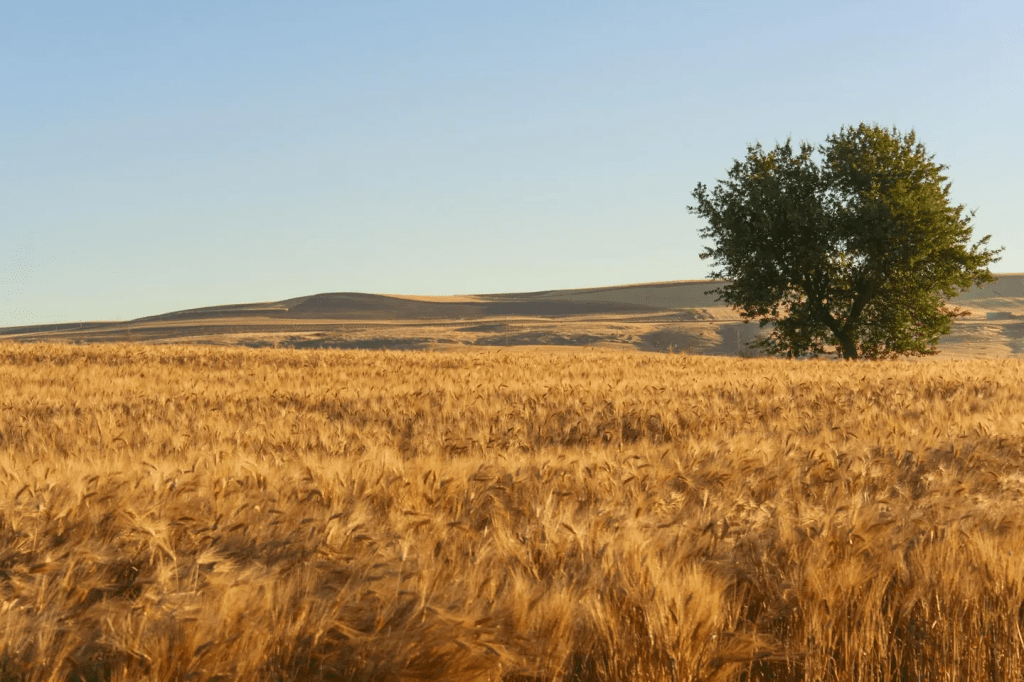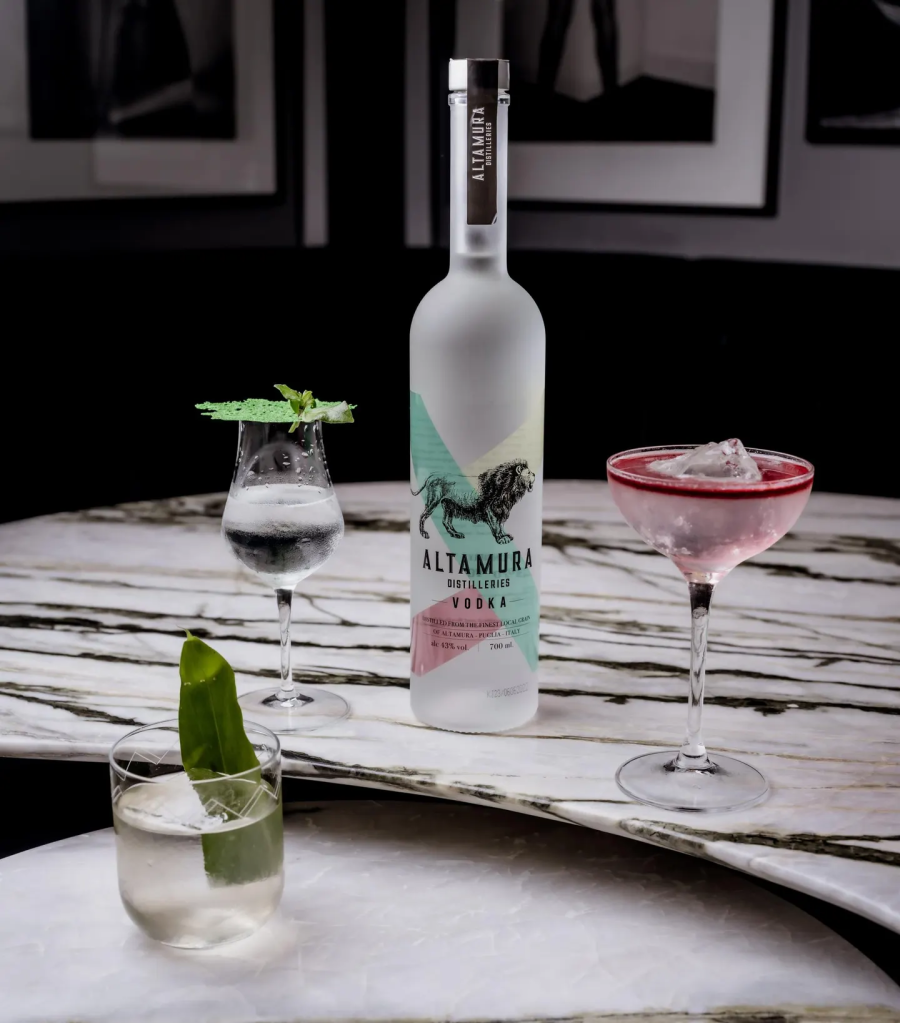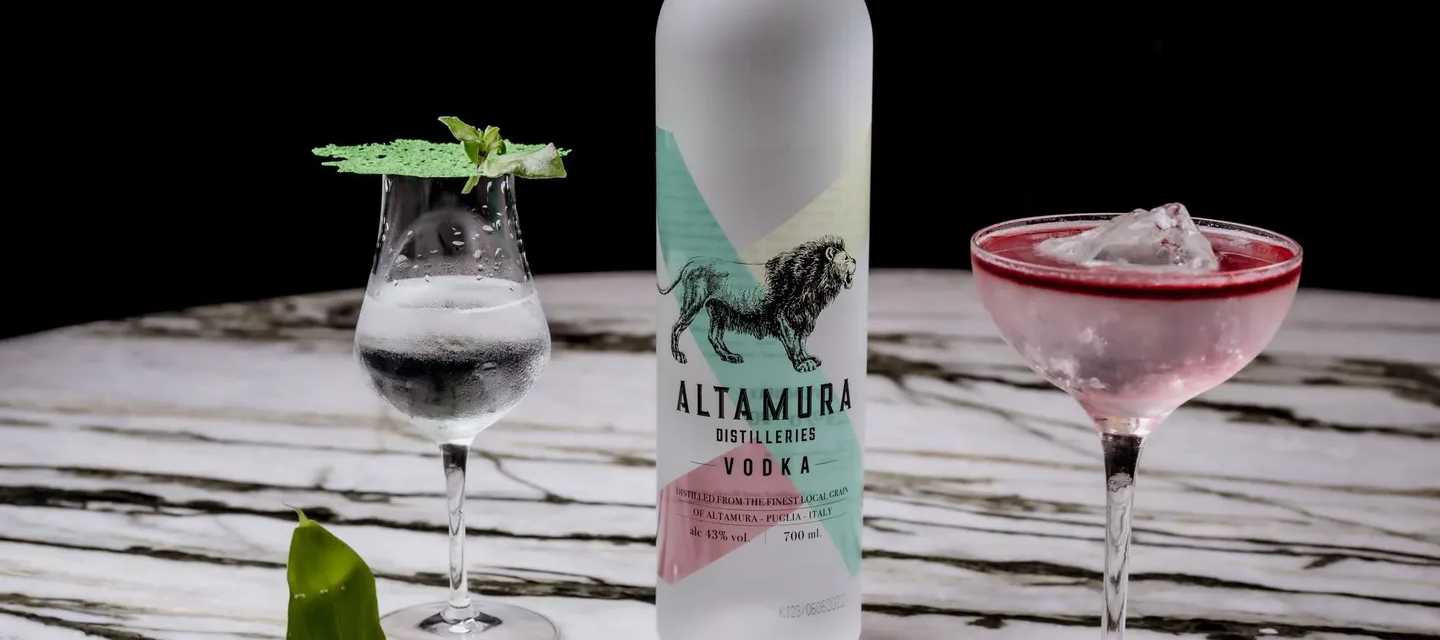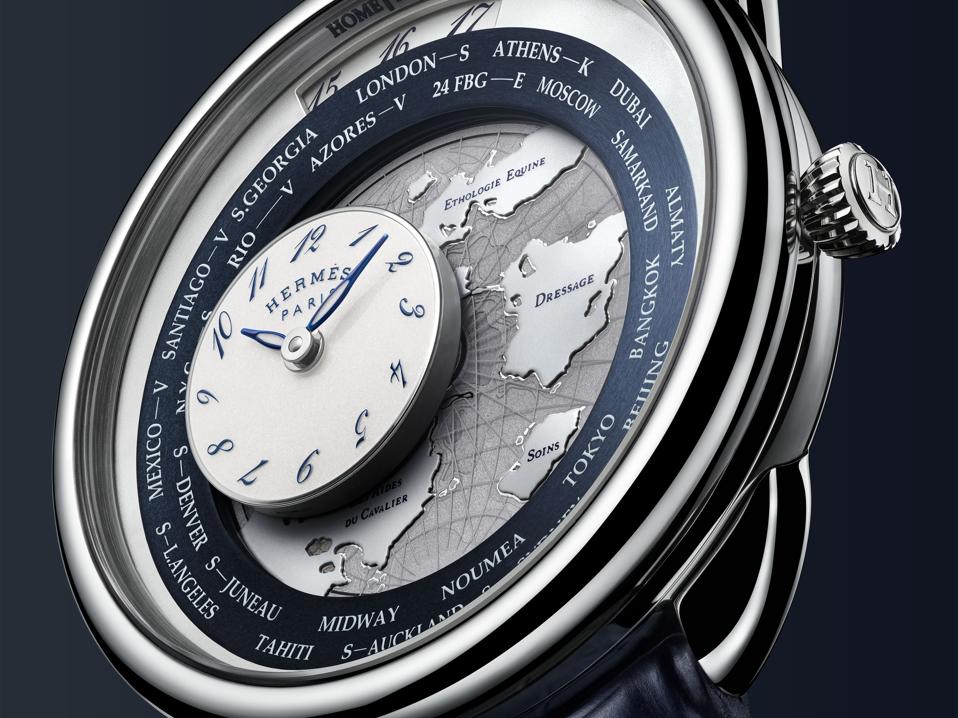Using an ancient wheat from Puglia, Frank Grillo’s Altamura vodka began with a simple idea: What if you could drink a loaf of bread?

Before he was distilling vodka, blue-haired Frank Grillo was in the middle of a pandemic-fueled cooking binge of specialties from Southern Italy’s Puglia region when he decided he could do better than the typical flour in his pantry.
The 58-year-old Grillo felt compelled to sample an ancient wheat he had been reading about, one that makes the only bread in the world with its own protected designation of origin.
Luckily, he only needed to travel to his local Whole Foods to find some flour from the Altamura region—known for flavors like aniseed, pepper and lemon zest. Back home in Atlanta, as Grillo baked his first loaf, a big idea hit him.
“Standing in my kitchen, I held up [the bread] and said, ‘If you boil that instead of baking it, we could be drinking it,’” Grillo recalls. “I got real curious why no one seemed to be distilling from this wheat.”
From that idea, Grillo launch Altamura Distilleries from Puglia.
He and his best friend and business partner Steve Acuña, a cofounder and head of the brand’s ready-to-serve beverages, split a little more than $500,000 from their savings to set up the business, iterate a vodka recipe and bottle their first run.
There are no institutional investors backing the brand—just some friends and family, who own a combined 40% stake, for about $1.6 million investment.
Bootstrapping the second phase came with some big decisions, such as holding off on building their own distillery in Puglia due to the expense.
For its initial production runs, Altamura vodka has been distilled by an independent manufacturer in Poland, using the wheat shipped directly from Italy, but that will change. The business now leases space in Ostuni as a distribution center.
The facility will also soon house Altamura’s gin experiment. By next year, Grillo’s vodka and whiskey distillery is slated to open in the city of Altamura.

Since its launch last year, Altamura’s vodka is now sold in seven countries including the U.S., U.K, and India.
Just under 50,000 bottles were sold during its first full year of business in 2023—amounting to a very modest $550,000 in annual sales. Grillo expects to triple that amount this year—projecting revenues close to $2 million.
Spirits, of course, are a high-profit business. Especially vodka—a $23 billion global market—which can be distilled within a few hours and requires no aging, leading to net margins that can top 70%.
Successful brands are often bought by larger conglomerates for enormous sums. Last November, for example, Brown-Forman sold Finlandia to Coca-Cola’s bottling company for $220 million.
And most entrepreneurs who enter the industry dream of deals that are even more lucrative than that because spirits deals command a premium. Some thirsty investors have recently acquired stakes in startup brands at multiples of as much as 30 times earnings.
In recent years, popular brands have sold for more than 5 times to as much as 10 times revenue, before factoring in the long-term performance incentives.
In 2020, Aviation Gin, which counted actor Ryan Reynolds as a key investor, sold to Diageo for $610 million. That’s a multiple of more than 8 times Aviation’s 2019 revenue—before the bonus incentives.
And three years earlier, Diageo famously purchased George Clooney and Rande Gerber’s tequila brand, Casamigos, for what may end up being as much as $1 billion after performance incentives.
Altamura Distilling is, of course, a long way from any kind of exit, but its already quite profitable. Forbes estimates that the brand has more than 50% net profit margins, though it’s very early in the startup journey.
“Making vodka is the easiest thing we do,” says Grillo, who now resides in the Pugliese town of 36,000 called Francavilla Fontana.
The biggest production issue come from everything but distilling, he says, such as securing bottles and boxes. Altamura’s glass bottles originally came from Ukraine, but most of the production moved to Poland after Russia’s invasion.
Grillo came to be a spirits entrepreneur by way of a longtime dream of living in Italy.
After spending many years as an Atlanta-based marketing executive, including as chief marketing officer for NASDAQ-traded agency Harte Hanks, he and his husband, Justin, decided to move to Puglia, located in Italy’s Southern heel due to the access to beaches and airports—on top of the tax breaks for moving to the region.
An Italian American, with mostly Sicilian roots, Grillo had never been to Puglia before.
To familiarize himself with the foods of his future home, he searched around and found a Food 52 recipe for a rustic bread, traditionally made with ancient wheat with a rich history grown around Alta Murgia National Park in the province of Foggia.
The Roman poet Horace even wrote about it dating back to 37 BC.
Grillo chewed over the idea of whether one could actually drink this terroir-driven bread.
Soon, he learned that some of the vodkas of Russia, Ukraine and Poland use the soft winter wheat, but the durum wheat growing in Italy’s hot Mediterranean climate could still be distilled into vodka like its northern cousin. The practice had just never caught on before.
Southern Italy’s generations of farmers preferred to use their wheat to make breads, pastas and pizza doughs.
“It was never in the culture here to look at wheat as something you would boil and distill,” says Grillo.

He’s been trying to change that. And Italy’s top bars and mixologists from around the world have already taken notice.
All five of the Italian watering holes on the World’s 50 Best Bars list for 2023 serve Altamura, and its frosted bottles emblazoned with a lion are served at some of the most acclaimed cocktail establishments around the world.
In Barcelona’s Paradiso, voted No. 1 on the list of The World’s 50 Best Bars in 2022, owner Giocomo Giannotti says his customers “notice a difference.” The vodka often used in martinis and espresso martinis, as well cosmopolitans and many other classic cocktails.
“He really understands the bartender,” says Giannotti. “They are a craft vodka made with high quality, raw materials. It’s a top-shelf product, and it’s filled a hole in the market.”
In New York City, Tokyo-born mixologist Takuma Watanabe has paired the vodka with avocado and lime.
“Compared to other vodka, it has texture, and it’s smoother,” says Watanabe, the co-founder and beverage director at downtown Manhattan bars Martiny’s and L’Americana. “Because of the texture, once we shake it, it gets more body.”
Influential bartenders are Grillo’s prime marketing targets for now. His strategy, he says, grew out of his agency days: “Know your customer and know the job you want to do.”
That’s why, when it comes to distilling down to the vodka’s essence, Grillo was sparing. Most premium vodkas are distilled five or seven times and boast of being odorless and tasteless.
But Grillo wanted the complete opposite for his vodka.
“We felt like we had to let you taste the wheat,” he explains. “The vodka has that essence and all of that comes from the wheat. There’s nothing we do. It’s pure.”
He settled on three distillations and five filtrations. Because Altamura’s durum wheat is much starchier than northern varieties of soft winter wheat, there’s a sweetness and creaminess to Altamura vodka—unlike other traditional vodka brands.
Grillo wanted to identify the specific flavors he could develop from distilling wheat farmed by the Altamura-based Cappiello family who have specialized in cultivating durum wheat since the late 1800s.
“We never thought that someone would ever distill vodka from our wheat,” says Andrea Cappiello, great-grandson of the farm’s founder. “Frank and Steve came to Italy without prior distillation experience, so it was hard to believe during our first meeting how this was going to work. However, from the beginning, we saw the determination in their eyes, which, combined with their passion and know-how, has brought them to where they are today.
“I feel the pride of the city of Altamura,” he continues. “My mission is to pass this on to the next generation, as the previous one did with me.”
From that first ancient harvest, Grillo has big expectations for the future. Up next are ready-to-drink vodka cocktails as well as an Altamura gin and a whiskey.
“We took a deep breath and said we need to focus and not divide marketing dollars,” says Grillo, adding that Altamura vodka launches in France, Poland and Australia this spring. “We are in way more countries than we thought we would be. I want to be careful not to overextend.”
But Grillo can’t deny that he wants to produce more. A whiskey drinker, he has studied how wheat is used in Scotland to produce Scotch.
That’s why he hopes he can reinvest some of the proceeds from his vodka towards creating his own whiskey. By next year, the plan is to use durum wheat to distill an American-style wheated whiskey—so it can start the three-to five-year aging process before bottling.
There are also plans for flavored vodkas—but only flavors that lean into the authenticity of the Pugliese wheat.
Inspired by a Pesto Martini with Altamura vodka at Milan’s Moebius– Grillo says he’s working on tomato vodka and basil vodka which would add the extra ingredients added in as part of the first round of distilling. Drinking bread was just a start, explains a grinning Grillo.
Drinking margherita pizza is what comes next, logically. Says Grillo, “People are inspired by the provenance.”
This article was first published on forbes.com and all figures are in USD.
This story featured in Issue 10 of Forbes Australia. Tap here to secure your copy.



